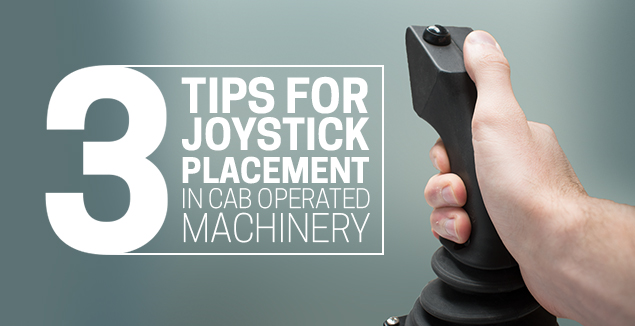
When choosing a joystick for a new machinery design or for retrofitting current equipment, it’s critical to not overlook the importance of the joystick’s physical placement within the cabin. Beyond the handle choice and the control functions, the physical location of the joystick(s) should be top priority to ensure operator comfort and most importantly, productivity.
To guide OEMs and machinery integrators down the right path, we have prepared the below points to consider when deciding on joystick placement in industrial equipment, such as off-highway equipment, maintenance machinery and cab-operated cranes.
1. Think Comfort
Operator comfort is becoming increasingly more important in many industries, as it supports productivity and worker safety. End users are now expecting OEMs and machinery integrators to offer equipment designed around this need. Comfort is typically focused on seating, but the placement of controls is also a major factor in comfortable machinery operation.
When deciding on the placement of your joystick, make sure it is comfortably located and unobstructed. Having to reach too far to operate the handle or having the handle located too close to the operator will not be ideal for operation. Make sure that the joystick location allows for adequate hand and knuckle clearance during handle activation. Restricting this clearance/space could potentially create a stressful operating position for the operator.
2. Align Location with Function
When determining the placement of the joystick, function should come into play. How should the joystick be arranged in relation to the equipment’s complementary control elements to maximize operating efficiencies? Think about how the operator will perform certain functions and in what order. Related control functions are typically grouped in relation to each other, so an operator can quickly and efficiently get his or her job done.
Also, what will be the operational frequency of the joystick’s intended function? Will it be continually used during operation or have low usage? Understanding the joystick’s duty cycle can also help dictate its placement. If it is estimated to have a low duty cycle, its placement can be deprioritized for other controls that will be used more frequently.
3. Steer Clear of Common Issues
Positioning a joystick in a cab, whether in a console or a panel, can seem simple, but it is important to avoid typical placement issues that have a tendency to be overlooked. Care should be taken to avoid locations:
Where inadvertent operation is possible. This could occur if the joystick is located too close to another control device.
Where the operator is able to apply an excessive amount of force to the control lever. As an example, a downward slanted mounting position that is tilted away from the operator could inadvertently cause this to happen – eventually damaging the handle and joystick.
Where the control handle is easily accessible to the doorway, where the operator could be tempted to use the handle to pull him/herself into the cabin. Industrial joysticks are characteristically robust and rugged, but they are not designed to withstand a person’s body weight.
Placement is just one of the many challenges that OEMs and machinery integrators face when choosing a joystick for their machinery. Contact us today for support with choosing and developing joysticks for cab-operated equipment and machinery.